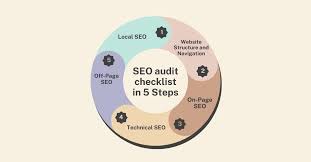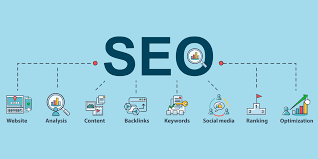Search engines are evolving rapidly, and in 2025, simply adding keywords or building backlinks isn’t enough to dominate the results page. If your website isn’t technically sound, you risk losing visibility no matter how good your content may be. This is where a Technical SEO Audit Checklist 2025 becomes essential.
In this blog, we’ll walk through the most important aspects of technical SEO in 2025, breaking down each step so you can optimize your site for crawling, indexing, speed, and user experience. By the end, you’ll have a full blueprint to future-proof your site.

The Technical SEO Audit Checklist 2025 doesn’t just highlight errors—it provides actionable solutions to strengthen your digital foundation. From Core Web Vitals and mobile-first design to structured data and secure HTTPS, every element plays a role in higher rankings. By consistently applying the Technical SEO Audit Checklist 2025, you’ll ensure that your site stays competitive, attracts organic traffic, and adapts to Google’s algorithm updates with ease.
🔍 What is a Technical SEO Audit?
A technical SEO audit is a systematic process of analyzing a website’s infrastructure to ensure that search engines can efficiently crawl, index, and rank it. Unlike on-page SEO, which focuses on content and keywords, or off-page SEO, which is about backlinks, technical SEO deals with the behind-the-scenes elements like:
• Crawlability and indexability
• Website performance and Core Web Vitals
• Mobile-first optimization
• Structured data and schema
• Security and HTTPS setup
A strong technical foundation is what allows your content and backlinks to truly perform. Without it, even the best-written articles may fail to appear on the first page of Google. Issues like broken links, slow-loading pages, poor mobile usability, or missing sitemaps can negatively impact your visibility. That’s why following a Technical SEO Audit Checklist 2025 is critical—it ensures every essential factor is addressed.

This checklist helps businesses uncover hidden errors, improve website speed, enhance user experience, and boost organic rankings. As Google updates its algorithms, the Technical SEO Audit Checklist 2025 provides a future-ready approach that aligns with the latest standards. For businesses aiming to stay competitive in search results, regular technical audits are no longer optional—they’re a necessity.
✅ Why Do You Need a Technical SEO Audit in 2025?
The digital landscape has changed dramatically. Google and other search engines now emphasize user experience, speed, and technical accuracy more than ever before. What ranked in 2023 or 2024 might not work today. A website that ignores technical SEO risks losing both visibility and valuable traffic. That’s why following the Technical SEO Audit Checklist 2025 is more important than ever.

• Faster Loading – Site speed is directly tied to search rankings and user retention.
• Mobile-First Indexing – With most users browsing on phones, Google prioritizes mobile-friendly websites.
• Better Indexing – Pages with proper metadata, sitemaps, and structured data have higher chances of ranking.
• Error Reduction – Identifying and fixing broken links, 404 errors, and duplicate pages improves site health.
• Improved Visibility – Strong technical SEO ensures your content actually appears where your audience can find it.
Without regular audits, even the best-written content may remain invisible to search engines. The Technical SEO Audit Checklist 2025 provides a structured roadmap to eliminate technical gaps, optimize performance, and future-proof your site. Whether you run an e-commerce store, a blog, or a business website, staying aligned with the Technical SEO Audit Checklist 2025 will give you a competitive edge in rankings and ensure your site adapts to Google’s evolving algorithms.
📋 Technical SEO Audit Checklist 2025 – Step by Step
Now, let’s break down the Technical SEO Audit Checklist 2025 into actionable steps:

1. Website Crawlability & Indexing
- Use tools like Screaming Frog or Sitebulb to check your site.
- Fix 404 errors, broken links, and redirect chains.
- Submit a fresh XML sitemap in Google Search Console.
- Review your robots.txt file to avoid blocking critical pages.
👉 Why it matters: If Google can’t crawl your pages, they won’t rank.
2. Core Web Vitals Optimization
- Improve Largest Contentful Paint (LCP) to under 2.5s.
- Minimize Cumulative Layout Shift (CLS).
- Enhance Interaction to Next Paint (INP).
👉 Core Web Vitals are major ranking signals in 2025, making them a must-have in any Technical SEO Audit Checklist 2025.
3. Mobile-First Optimization
- Test your website across multiple devices.
- Ensure responsive layouts and avoid intrusive pop-ups.
- Optimize clickable elements for easy navigation.
👉 Since Google uses mobile-first indexing, this step is critical.
4. Site Speed and Performance
- Compress images into modern formats like WebP or AVIF.
- Implement a Content Delivery Network (CDN).
- Minify CSS, HTML, and JavaScript.
- Enable caching for repeat visitors.
👉 A slow site loses both rankings and conversions.
5. HTTPS and Website Security
- Use SSL certificates across all pages.
- Fix mixed content warnings.
- Regularly update your security setup.
👉 Google prioritizes secure websites, making HTTPS non-negotiable.
6. Structured Data & Schema Markup
- Add schema for articles, FAQs, reviews, or products.
- Test with Google’s Rich Results Tool.
- Monitor errors in Search Console.
👉 Schema boosts your chances of appearing in rich snippets.
7. Canonicalization & Duplicate Content Fixes
- Use canonical tags to identify primary versions of pages.
- Eliminate duplicate URLs from query parameters.
- Consolidate similar content with redirects.
👉 This prevents Google from splitting ranking signals.
8. Internal Linking & Site Architecture
👉 A strong site structure improves both navigation and crawlability.
- Keep a flat site structure (3 clicks or fewer from the homepage).
- Use descriptive, keyword-rich anchor text.
- Ensure every important page is properly linked.
9. Crawl Budget Optimization
- Block irrelevant URLs like internal search results.
- Eliminate long redirect chains.
- Highlight priority pages in your XML sitemap.
👉 For large sites, this ensures Google focuses on the right content.
10. International SEO & Hreflang Tags
- Implement hreflang tags for multilingual websites.
- Avoid duplicate content across regions.
👉 If you’re targeting global users, this step is essential in your Technical SEO Audit Checklist 2025.
11. Log File Analysis
- Check server logs to understand how Googlebot crawls your site.
- Identify wasted crawl budget and fix crawl traps.
👉 Useful for enterprise-level websites with thousands of URLs.
12. Redirects & Broken Links
- Always use 301 redirects for permanent changes.
- Limit the use of 302 redirects.
- Routinely scan for broken internal and external links.
👉 Clean redirects protect user experience and preserve ranking power.
13. Image & Video Optimization
- Add alt text with descriptive keywords.
- Enable lazy loading for faster rendering.
- Optimize video embedding to avoid slow performance.
👉 Multimedia helps rankings but only if optimized properly.
14. Analytics & Tracking Setup
- Ensure Google Analytics 4 is installed.
- Use Google Tag Manager for event tracking.
- Monitor traffic and ranking improvements consistently.
👉 Without proper tracking, you can’t measure SEO results.
🏆 Benefits of Following the Technical SEO Audit Checklist 2025
By applying the Technical SEO Audit Checklist 2025, you’ll experience:

• Higher visibility in SERPs – Search engines reward technically sound websites with better rankings.
• Faster site performance – Speed optimization reduces bounce rates and keeps users engaged.
• Stronger chances of ranking for competitive keywords – Well-structured websites are easier for Google to crawl and index.
• Improved user engagement and conversions – A smooth, error-free site keeps visitors browsing longer.
• Long-term SEO stability – Regular audits help maintain performance even as algorithms evolve.
But the benefits go beyond these points. A technical audit ensures that hidden issues like duplicate content, missing alt tags, unoptimized URLs, or broken internal links don’t stop your site from reaching its full potential. In today’s digital space, user experience is everything, and a technically optimized site directly impacts trust, credibility, and business growth.
The Technical SEO Audit Checklist 2025 acts as a blueprint for sustainable success. It not only helps you fix errors but also strengthens the overall website framework, ensuring your digital presence can adapt to future search trends. By consistently following the Technical SEO Audit Checklist 2025, businesses secure higher rankings, more traffic, and a reliable foundation for long-term online growth.
📌 Final Thoughts
SEO is no longer just about writing good content. In 2025, it’s about making sure that content can be discovered, indexed, and displayed effectively by search engines. That’s why the Technical SEO Audit Checklist 2025 is your ultimate tool for success.
Before you invest in more content or backlinks, take time to run a complete audit using this checklist. By doing so, you’ll ensure your website is fast, secure, mobile-friendly, and fully optimized for today’s search engines. A technically strong site not only ranks higher but also provides users with a smooth experience that increases trust and conversion rates.
Another key benefit of using the Technical SEO Audit Checklist 2025 is its adaptability. As Google continues to roll out updates and AI-driven search evolves, this checklist helps you stay one step ahead. From fixing crawl errors and improving Core Web Vitals to enhancing structured data, it covers all aspects that truly matter for long-term growth.
In short, the Technical SEO Audit Checklist 2025 isn’t just a set of tasks—it’s your roadmap to higher rankings, more traffic, and stronger online visibility. By making technical SEO a priority, you prepare your website for sustainable success in the digital era.

